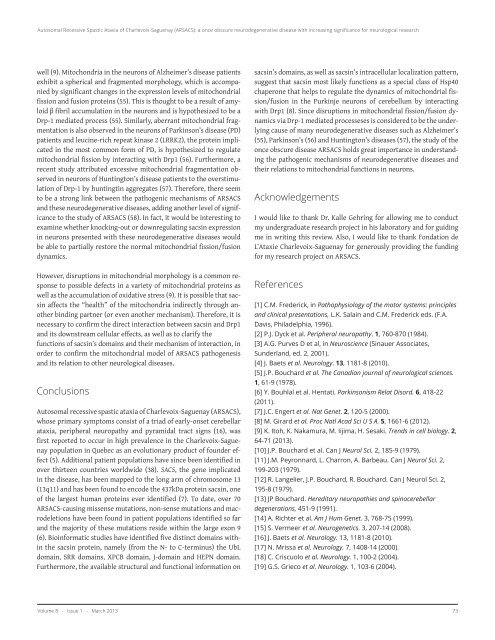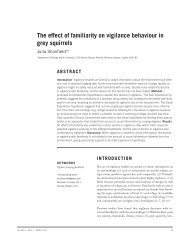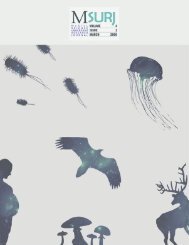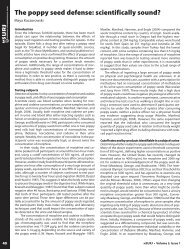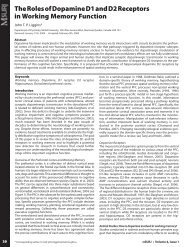the entire issue - McGill Science Undergraduate Research Journal ...
the entire issue - McGill Science Undergraduate Research Journal ...
the entire issue - McGill Science Undergraduate Research Journal ...
Create successful ePaper yourself
Turn your PDF publications into a flip-book with our unique Google optimized e-Paper software.
Autosomal Recessive Spastic Ataxia of Charlevoix-Saguenay (ARSACS): a once obscure neurodegenerative disease with increasing significance for neurological research<br />
well (9). Mitochondria in <strong>the</strong> neurons of Alzheimer’s disease patients<br />
exhibit a spherical and fragmented morphology, which is accompanied<br />
by significant changes in <strong>the</strong> expression levels of mitochondrial<br />
fission and fusion proteins (55). This is thought to be a result of amyloid<br />
β fibril accumulation in <strong>the</strong> neurons and is hypo<strong>the</strong>sized to be a<br />
Drp-1 mediated process (55). Similarly, aberrant mitochondrial fragmentation<br />
is also observed in <strong>the</strong> neurons of Parkinson’s disease (PD)<br />
patients and leucine-rich repeat kinase 2 (LRRK2), <strong>the</strong> protein implicated<br />
in <strong>the</strong> most common form of PD, is hypo<strong>the</strong>sized to regulate<br />
mitochondrial fission by interacting with Drp1 (56). Fur<strong>the</strong>rmore, a<br />
recent study attributed excessive mitochondrial fragmentation observed<br />
in neurons of Huntington’s disease patients to <strong>the</strong> overstimulation<br />
of Drp-1 by huntingtin aggregates (57). Therefore, <strong>the</strong>re seem<br />
to be a strong link between <strong>the</strong> pathogenic mechanisms of ARSACS<br />
and <strong>the</strong>se neurodegenerative diseases, adding ano<strong>the</strong>r level of significance<br />
to <strong>the</strong> study of ARSACS (58). In fact, it would be interesting to<br />
examine whe<strong>the</strong>r knocking-out or downregulating sacsin expression<br />
in neurons presented with <strong>the</strong>se neurodegenerative diseases would<br />
be able to partially restore <strong>the</strong> normal mitochondrial fission/fusion<br />
dynamics.<br />
However, disruptions in mitochondrial morphology is a common response<br />
to possible defects in a variety of mitochondrial proteins as<br />
well as <strong>the</strong> accumulation of oxidative stress (9). It is possible that sacsin<br />
affects <strong>the</strong> “health” of <strong>the</strong> mitochondria indirectly through ano<strong>the</strong>r<br />
binding partner (or even ano<strong>the</strong>r mechanism). Therefore, it is<br />
necessary to confirm <strong>the</strong> direct interaction between sacsin and Drp1<br />
and its downstream cellular effects, as well as to clarify <strong>the</strong><br />
functions of sacsin’s domains and <strong>the</strong>ir mechanism of interaction, in<br />
order to confirm <strong>the</strong> mitochondrial model of ARSACS pathogenesis<br />
and its relation to o<strong>the</strong>r neurological diseases.<br />
Conclusions<br />
Autosomal recessive spastic ataxia of Charlevoix-Saguenay (ARSACS),<br />
whose primary symptoms consist of a triad of early-onset cerebellar<br />
ataxia, peripheral neuropathy and pyramidal tract signs (16), was<br />
first reported to occur in high prevalence in <strong>the</strong> Charlevoix-Saguenay<br />
population in Quebec as an evolutionary product of founder effect<br />
(5). Additional patient populations have since been identified in<br />
over thirteen countries worldwide (38). SACS, <strong>the</strong> gene implicated<br />
in <strong>the</strong> disease, has been mapped to <strong>the</strong> long arm of chromosome 13<br />
(13q11) and has been found to encode <strong>the</strong> 437kDa protein sacsin, one<br />
of <strong>the</strong> largest human proteins ever identified (7). To date, over 70<br />
ARSACS-causing missense mutations, non-sense mutations and macrodeletions<br />
have been found in patient populations identified so far<br />
and <strong>the</strong> majority of <strong>the</strong>se mutations reside within <strong>the</strong> large exon 9<br />
(6). Bioinformatic studies have identified five distinct domains within<br />
<strong>the</strong> sacsin protein, namely (from <strong>the</strong> N- to C-terminus) <strong>the</strong> UbL<br />
domain, SRR domains, XPCB domain, J-domain and HEPN domain.<br />
Fur<strong>the</strong>rmore, <strong>the</strong> available structural and functional information on<br />
sacsin’s domains, as well as sacsin’s intracellular localization pattern,<br />
suggest that sacsin most likely functions as a special class of Hsp40<br />
chaperone that helps to regulate <strong>the</strong> dynamics of mitochondrial fission/fusion<br />
in <strong>the</strong> Purkinje neurons of cerebellum by interacting<br />
with Drp1 (8). Since disruptions in mitochondrial fission/fusion dynamics<br />
via Drp-1 mediated processeses is considered to be <strong>the</strong> underlying<br />
cause of many neurodegenerative diseases such as Alzheimer’s<br />
(55), Parkinson’s (56) and Huntington’s diseases (57), <strong>the</strong> study of <strong>the</strong><br />
once obscure disease ARSACS holds great importance in understanding<br />
<strong>the</strong> pathogenic mechanisms of neurodegenerative diseases and<br />
<strong>the</strong>ir relations to mitochondrial functions in neurons.<br />
Acknowledgements<br />
I would like to thank Dr. Kalle Gehring for allowing me to conduct<br />
my undergraduate research project in his laboratory and for guiding<br />
me in writing this review. Also, I would like to thank Fondation de<br />
L’Ataxie Charlevoix-Saguenay for generously providing <strong>the</strong> funding<br />
for my research project on ARSACS.<br />
References<br />
[1] C.M. Frederick, in Pathophysiology of <strong>the</strong> motor systems: principles<br />
and clinical presentations, L.K. Salain and C.M. Frederick eds. (F.A.<br />
Davis, Philadelphia, 1996).<br />
[2] P.J. Dyck et al. Peripheral neuropathy. 1, 760-870 (1984).<br />
[3] A.G. Purves D et al, in Neuroscience (Sinauer Associates,<br />
Sunderland, ed. 2, 2001).<br />
[4] J. Baets et al. Neurology. 13, 1181-8 (2010).<br />
[5] J.P. Bouchard et al. The Canadian journal of neurological sciences.<br />
1, 61-9 (1978).<br />
[6] Y. Bouhlal et al. Hentati. Parkinsonism Relat Disord. 6, 418-22<br />
(2011).<br />
[7] J.C. Engert et al. Nat Genet. 2, 120-5 (2000).<br />
[8] M. Girard et al. Proc Natl Acad Sci U S A. 5, 1661-6 (2012).<br />
[9] K. Itoh, K. Nakamura, M. Iijima, H. Sesaki. Trends in cell biology. 2,<br />
64-71 (2013).<br />
[10] J.P. Bouchard et al. Can J Neurol Sci. 2, 185-9 (1979).<br />
[11] J.M. Peyronnard, L. Charron, A. Barbeau. Can J Neurol Sci. 2,<br />
199-203 (1979).<br />
[12] R. Langelier, J.P. Bouchard, R. Bouchard. Can J Neurol Sci. 2,<br />
195-8 (1979).<br />
[13] JP Bouchard. Hereditary neuropathies and spinocerebellar<br />
degenerations, 451-9 (1991).<br />
[14] A. Richter et al. Am J Hum Genet. 3, 768-75 (1999).<br />
[15] S. Vermeer et al. Neurogenetics. 3, 207-14 (2008).<br />
[16] J. Baets et al. Neurology. 13, 1181-8 (2010).<br />
[17] N. Mrissa et al. Neurology. 7, 1408-14 (2000).<br />
[18] C. Criscuolo et al. Neurology. 1, 100-2 (2004).<br />
[19] G.S. Grieco et al. Neurology. 1, 103-6 (2004).<br />
Volume 8 - Issue 1 - March 2013 73


